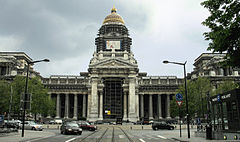Palais de Justice (Brussels)
| Palace of Justice | |
|---|---|
|
|

Main façade being renovated
|
|
| General information | |
| Architectural style | |
| Location | Brussels, Belgium |
| Coordinates | 50°50′12″N 4°21′06″E / 50.83667°N 4.35167°ECoordinates: 50°50′12″N 4°21′06″E / 50.83667°N 4.35167°E |
| Current tenants | Belgian court |
| Construction started | 31 October 1866 |
| Inaugurated | 15 October 1883 |
| Cost | 45 million Belgian franc |
| Client | Belgian government |
| Owner | Belgian government |
| Height | 104 metres (341 ft) |
| Dimensions | |
| Diameter | 160 by 150 metres (520 ft × 490 ft) |
| Technical details | |
| Floor area | 26,000 square metres (280,000 sq ft) |
| Design and construction | |
| Architect | Joseph Poelaert |
The Palace of Justice (French: Palais de Justice, Dutch: ![]() Justitiepaleis ) or Law Courts of Brussels is the most important court building in Belgium and the largest courthouse in the world.
Justitiepaleis ) or Law Courts of Brussels is the most important court building in Belgium and the largest courthouse in the world.
It was built between 1866 and 1883 in the eclectic style by the celebrated architect Joseph Poelaert. The total cost of the construction, land and furnishings was somewhere in the region of 45 million Belgian francs. It is reputed to be the largest building constructed in the 19th century. It is a notable landmark of Brussels.
In 1860, during the reign of Leopold I, a Royal decree announced the building of the Palace of Justice and an international architecture contest was organised for its design. The designs entered in the contest were found to be unacceptable and were thus rejected. The then minister of justice Tesch appointed Joseph Poelaert to design the building in 1861. The first stone was laid on October 31, 1866, and the building was inaugurated on October 15, 1883, four years after Poelaert's death in 1879.
For the building of the Palace of Justice, a section of the Marollen neighbourhood was demolished, while most of the park belonging to the House of Mérode was also expropriated. The 75 landlord owners of the houses, many of whom lived in their homes, received large indemnities, while the other inhabitants, about a hundred, were also forced to move by the Belgian government, though they were compensated with houses in the garden city "Tillens-Roosendael" (French: cité-jardin Tillens-Roosendael) in the municipality of Uccle, in the Quartier du Chat.
...
Wikipedia
